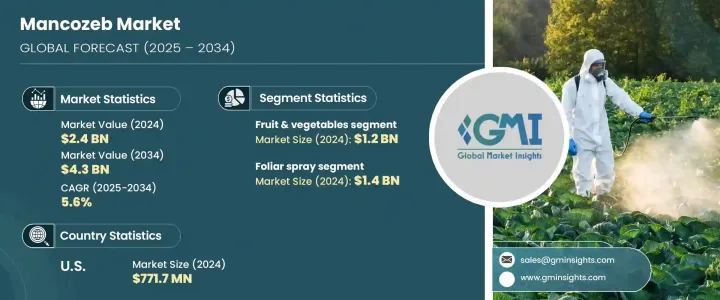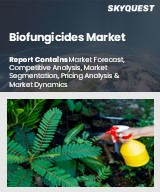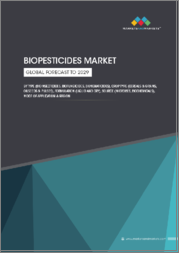
|
시장보고서
상품코드
1740800
세계의 만코제브 시장 : 기회, 성장 촉진요인, 산업 동향 분석과 예측(2025-2034년)Mancozeb Market Opportunity, Growth Drivers, Industry Trend Analysis, and Forecast 2025 - 2034 |
||||||
세계의 만코제브 시장은 2024년 24억 달러로 평가되었으며, 효과적인 작물 보호 솔루션에 대한 수요가 증가함에 따라 CAGR 5.6%로 성장하여 2034년까지 43억 달러에 이를 것으로 추정됩니다.
세계의 농업이 기후 변화, 토양 열화, 병해의 발생과 같은 과제의 증대에 직면하는 가운데, 농가는 작물의 수율을 지키고 식량 안보를 유지하기 위해, 만코제브와 같은 신뢰성이 높은 살균제에 눈을 돌리고 있습니다. 뿐만 아니라 박박한 경제 상황 하에서도 비용 대비 효과를 유지할 수 있는 제품이 요구되고 있습니다. 하지 않고, 균류 병해를 관리하는 지속 가능한 방법을 요구하고 있기 때문에 종합적 병해충 관리 프로그램에 있어서의 만코제브의 역할은 계속 확대되고 있습니다. 특히 아시아나 라틴아메리카의 신흥 경제 제국에서는 농업의 집약화가 진행되고 있어, 주년재 배의 중요성이 높아지고 있는 것도, 시장의 기세를 한층 더 가속시키고 있습니다. 식이의 안전에 대한 관심 증가와, 1에이커당의 농업 생산고를 극대화하려고 하는 움직임은 세계에서 높은 수준의 만코제브 채용을 유지할 것으로 예측됩니다.

폭넓은 스펙트럼을 가진 만코제브는 경쟁력 있는 가격으로 다양한 진균병원균을 관리할 수 있는 살균제로서 선택되고 있습니다. 특히 아시아의 일부 등 다작이나 집약적인 농업 관행이 지배적입니다. 멀티 사이트 작용은 저항성의 리스크를 대폭 저감해, 생육기를 거쳐 반복 살포해도 신뢰성이 높은 보호를 제공합니다.
| 시장 범위 | |
|---|---|
| 시작 연도 | 2024년 |
| 예측 연도 | 2025-2034년 |
| 시작 금액 | 24억 달러 |
| 예측 금액 | 43억 달러 |
| CAGR | 5.6% |
과일 및 야채 분야는 2024년에 12억 달러를 차지하고 만코제브 시장을 리드하고 있습니다. 포도, 토마토, 오이 등의 과일은 효과적인 치료를 실시하지 않으면 수율이 현저하게 저하됩니다. 만코제브는 노균병과 엽고병을 포함한 광범위한 곰팡이를 대상으로 하는 능력이 있기 때문에 과일 및 채소 생산자의 정평이 되어 농업 분야에서의 매력을 높입니다.
엽면 살포제 분야는 2024년에 14억 달러가 되는 큰 시장 점유율을 차지하고 있으며, 2034년까지 연평균 복합 성장률(CAGR) 5.7%를 보일 것으로 예측됩니다.
미국의 만코제브 시장은 2024년에 7억 7,170만 달러로 평가되었으며, 작물 수율과 품질 향상에 대한 관심이 높아지며, 2025년부터 2034년까지 연평균 복합 성장률(CAGR) 5.2%를 보일 것으로 예측됩니다. 감자와 토마토의 주요 곰팡이 위협에 대해 저렴한 가격으로 높은 효과를 발휘하는 만코제브는 미국의 농업 해충 관리 전략의 요점이 되고 있습니다.
만코제브 세계 시장에서 주요 기업은 Dow AgroSciences, United Phosphorus Limited, Zagro, Indofil 등이 있습니다.이러한 기업은 제품 라인을 적극적으로 확대되어 보다 안전하고 효율적인 제제를 혁신해, 농업 기관과 전략적 파트너십을 맺는 것으로, 진화하는 시장 수요에 선두를 두고 있습니다.
목차
제1장 조사 방법과 범위
제2장 주요 요약
제3장 업계 인사이트
- 생태계 분석
- 밸류체인에 영향을 주는 요인
- 이익률 분석
- 혁신
- 미래의 전망
- 제조업자
- 리셀러
- 트럼프 정권에 의한 관세에 대한 영향
- 무역에 미치는 영향
- 무역량의 혼란
- 보복 조치
- 업계에 미치는 영향
- 공급측의 영향(원재료)
- 주요 원재료의 가격 변동
- 공급망 재구성
- 생산 비용에 미치는 영향
- 수요측의 영향(판매가격)
- 최종 시장에의 가격 전달
- 시장 점유율 동향
- 소비자의 반응 패턴
- 공급측의 영향(원재료)
- 영향을 받는 주요 기업
- 전략적인 업계 대응
- 공급망 재구성
- 가격 설정 및 제품 전략
- 정책관여
- 전망과 향후 검토 사항
- 무역에 미치는 영향
- 무역 통계(HS코드)
- 주요 수출국
- 주요 수입국
참고: 위의 무역 통계는 주요 국가에 대해서만 제공됩니다.
- 이익률 분석
- 주요 뉴스와 대처
- 규제 상황
- 영향요인
- 성장 촉진요인
- 감자, 토마토, 포도 등 주요 작물에서 진균성 질환의 발생률이 상승하
- 증가하는 식량 수요를 충족시키기 위한 세계 농업 생산 확대
- 대체 살균제와 비교한 만코제브의 비용효과
- 농업 부문의 확대에 수반해, 신흥 시장에서 만코제브의 채용이 증가
- 업계의 잠재적 위험 및 과제
- 농업에서의 화학물질의 사용에 대한 엄격한 규제
- 환경 친화적이고 지속 가능한 작물 보호 솔루션에 대한 관심이 상승
- 성장 촉진요인
- 성장 가능성 분석
- Porter's Five Forces 분석
- PESTEL 분석
제4장 경쟁 구도
- 소개
- 기업의 시장 점유율 분석
- 경쟁 포지셔닝 매트릭스
- 전략적 전망 매트릭스
제5장 시장 추계 및 예측 : 형태별, 2021-2034년
- 주요 동향
- 건조
- 액체
제6장 시장 추계 및 예측 : 적용 방법별, 2021-2034년
- 주요 동향
- 엽면 살포제
- 토양 처리
- 종자 처리
제7장 시장 추계 및 예측 : 작물별, 2021-2034년
- 주요 동향
- 과일 및 채소
- 곡물
- 지방종자 및 콩류
- 기타
제8장 시장 추계 및 예측 : 용도별, 2021-2034년
- 주요 동향
- 농업
- 농장 및 영지
- 원예 및 관상용 작물
- 잔디 및 관상용 식물
- 기타
제9장 시장 추계 및 예측 : 지역별, 2021-2034년
- 주요 동향
- 북미
- 미국
- 캐나다
- 유럽
- 영국
- 독일
- 프랑스
- 이탈리아
- 스페인
- 러시아
- 아시아태평양
- 중국
- 인도
- 일본
- 한국
- 호주
- 라틴아메리카
- 브라질
- 멕시코
- 중동 및 아프리카
- 남아프리카
- 사우디아라비아
- 아랍에미리트(UAE)
제10장 기업 프로파일
- ABP Food Group
- Arrow Oils
- Baker Commodities
- Brocklesby
- Darling Ingredients
- Grand Natural
- Greasecycle
- MBP Solutions
- Munzer
- Oz Oils Pty
- Uranus Oil
The Global Mancozeb Market was valued at USD 2.4 billion in 2024 and is estimated to grow at a CAGR of 5.6% to reach USD 4.3 billion by 2034, driven by rising demand for effective crop protection solutions. As global agriculture faces increasing challenges from climate change, soil degradation, and disease outbreaks, farmers are turning to reliable fungicides like mancozeb to safeguard crop yields and maintain food security. Modern farming practices demand products that not only offer broad-spectrum efficacy but also remain cost-effective under tightening economic conditions. Mancozeb, with its proven multi-site mode of action, stands out as a fungicide that delivers both performance and value. Its role in integrated pest management programs continues to expand as producers seek sustainable ways to manage fungal diseases without accelerating resistance development. The ongoing intensification of agriculture, particularly in developing economies across Asia and Latin America, coupled with the growing importance of year-round cultivation, further fuels the market's momentum. Rising concerns around food safety and the push toward maximizing agricultural output per acre are expected to sustain high levels of mancozeb adoption worldwide.

With its broad-spectrum effectiveness, mancozeb has become the fungicide of choice for managing a range of fungal pathogens at a competitive price. Demand is particularly robust in regions where multi-cropping and intensive agricultural practices dominate, such as parts of Asia. Mancozeb plays a critical role in protecting crops like potatoes, grapes, and tomatoes, helping farmers ensure consistent yield and quality amid unpredictable environmental conditions. Its multi-site action significantly reduces the risk of resistance, offering reliable protection even with repeated applications across growing seasons. In areas where land resources are limited and productivity is vital, mancozeb remains a key input in crop protection programs. Its preventive capabilities during early growth stages are especially valued, helping strengthen overall plant health throughout the season.
| Market Scope | |
|---|---|
| Start Year | 2024 |
| Forecast Year | 2025-2034 |
| Start Value | $2.4 Billion |
| Forecast Value | $4.3 Billion |
| CAGR | 5.6% |
The fruit and vegetable segment leads the mancozeb market, accounting for USD 1.2 billion in 2024, fueled by the urgent need to safeguard high-value crops from devastating fungal diseases. Fruits such as grapes, tomatoes, and cucumbers suffer significant yield losses without effective treatment. Mancozeb's ability to target a wide range of fungi, including downy mildew and late blight, makes it a staple for fruit and vegetable growers, enhancing its appeal in the agricultural sector.
The foliar spray segment holds a significant market share, valued at USD 1.4 billion in 2024, and is projected to grow at a CAGR of 5.7% through 2034. Farmers favor foliar sprays for their simplicity and effectiveness, delivering direct protection to the most vulnerable parts of crops. The method's versatility and ability to support both preventive and curative applications continue to drive market demand.
The U.S. Mancozeb Market was valued at USD 771.7 million in 2024 and is expected to grow at a CAGR of 5.2% from 2025 to 2034, fueled by the increasing focus on enhancing crop yields and quality. Affordable and highly effective against key fungal threats in potatoes and tomatoes, mancozeb has become a cornerstone of U.S. agricultural pest management strategies. The integration of precision farming practices further amplifies its efficient use across American farmlands.
Major players in the Global Mancozeb Market include Dow AgroSciences, United Phosphorus Limited, Zagro, and Indofil. These companies are actively expanding product lines, innovating safer and more efficient formulations, and forming strategic partnerships with agricultural institutions to stay ahead of evolving market demands. Strengthening regional manufacturing and distribution networks remains a key strategy to capture growth opportunities in emerging economies.
Table of Contents
Chapter 1 Methodology & Scope
- 1.1 Market scope & definitions
- 1.2 Base estimates & calculations
- 1.3 Forecast calculations
- 1.4 Data sources
- 1.4.1 Primary
- 1.4.2 Secondary
- 1.4.2.1 Paid sources
- 1.4.2.2 Public sources
Chapter 2 Executive Summary
- 2.1 Industry synopsis, 2021-2034
Chapter 3 Industry Insights
- 3.1 Industry ecosystem analysis
- 3.1.1 Factor affecting the value chain
- 3.1.2 Profit margin analysis
- 3.1.3 Disruptions
- 3.1.4 Future outlook
- 3.1.5 Manufacturers
- 3.1.6 Distributors
- 3.2 Trump administration tariffs
- 3.2.1 Impact on trade
- 3.2.1.1 Trade volume disruptions
- 3.2.1.2 Retaliatory measures
- 3.2.2 Impact on the industry
- 3.2.2.1 Supply-side impact (raw materials)
- 3.2.2.1.1 Price volatility in key materials
- 3.2.2.1.2 Supply chain restructuring
- 3.2.2.1.3 Production cost implications
- 3.2.2.2 Demand-side impact (selling price)
- 3.2.2.2.1 Price transmission to end markets
- 3.2.2.2.2 Market share dynamics
- 3.2.2.2.3 Consumer response patterns
- 3.2.2.1 Supply-side impact (raw materials)
- 3.2.3 Key companies impacted
- 3.2.4 Strategic industry responses
- 3.2.4.1 Supply chain reconfiguration
- 3.2.4.2 Pricing and product strategies
- 3.2.4.3 Policy engagement
- 3.2.5 Outlook and future considerations
- 3.2.1 Impact on trade
- 3.3 Trade statistics (hs code)
- 3.3.1 Major exporting countries
- 3.3.2 Major importing countries
Note: the above trade statistics will be provided for key countries only.
- 3.4 Profit margin analysis
- 3.5 Key news & initiatives
- 3.6 Regulatory landscape
- 3.7 Impact forces
- 3.7.1 Growth drivers
- 3.7.1.1 Rising incidence of fungal diseases in key crops like potatoes, tomatoes, and grapes.
- 3.7.1.2 Expansion of global agricultural production to meet growing food demand.
- 3.7.1.3 Cost-effectiveness of mancozeb compared to alternative fungicides.
- 3.7.1.4 Increased adoption of mancozeb in emerging markets with expanding agricultural sectors.
- 3.7.2 Industry pitfalls & challenges
- 3.7.2.1 Stringent regulatory restrictions on chemical use in agriculture.
- 3.7.2.2 Growing preference for environmentally friendly and sustainable crop protection solutions.
- 3.7.1 Growth drivers
- 3.8 Growth potential analysis
- 3.9 Porter's analysis
- 3.10 PESTEL analysis
Chapter 4 Competitive Landscape, 2024
- 4.1 Introduction
- 4.2 Company market share analysis
- 4.3 Competitive positioning matrix
- 4.4 Strategic outlook matrix
Chapter 5 Market Estimates & Forecast, By Form, 2021-2034 (USD Billion) (Kilo Tons)
- 5.1 Key trends
- 5.2 Dry
- 5.3 Liquid
Chapter 6 Market Estimates & Forecast, By Mode of Application, 2021-2034 (USD Billion) (Kilo Tons)
- 6.1 Key trends
- 6.2 Foliar spray
- 6.3 Soil treatment
- 6.4 Seed treatment
Chapter 7 Market Estimates & Forecast, By Crop Type, 2021-2034 (USD Billion) (Kilo Tons)
- 7.1 Key trends
- 7.2 Fruits & vegetables
- 7.3 Cereals & grains
- 7.4 Oilseeds & pulses
- 7.5 Others
Chapter 8 Market Estimates & Forecast, By Application, 2021-2034 (USD Billion) (Kilo Tons)
- 8.1 Key trends
- 8.2 Agriculture
- 8.3 Plantation and estates
- 8.4 Horticulture and ornamental crops
- 8.5 Turf & ornamentals
- 8.6 Others
Chapter 9 Market Estimates & Forecast, By Region, 2021-2034 (USD Billion) (Kilo Tons)
- 9.1 Key trends
- 9.2 North America
- 9.2.1 U.S.
- 9.2.2 Canada
- 9.3 Europe
- 9.3.1 UK
- 9.3.2 Germany
- 9.3.3 France
- 9.3.4 Italy
- 9.3.5 Spain
- 9.3.6 Russia
- 9.4 Asia Pacific
- 9.4.1 China
- 9.4.2 India
- 9.4.3 Japan
- 9.4.4 South Korea
- 9.4.5 Australia
- 9.5 Latin America
- 9.5.1 Brazil
- 9.5.2 Mexico
- 9.6 MEA
- 9.6.1 South Africa
- 9.6.2 Saudi Arabia
- 9.6.3 UAE
Chapter 10 Company Profiles
- 10.1 ABP Food Group
- 10.2 Arrow Oils
- 10.3 Baker Commodities
- 10.4 Brocklesby
- 10.5 Darling Ingredients
- 10.6 Grand Natural
- 10.7 Greasecycle
- 10.8 MBP Solutions
- 10.9 Munzer
- 10.10 Oz Oils Pty
- 10.11 Uranus Oil



















